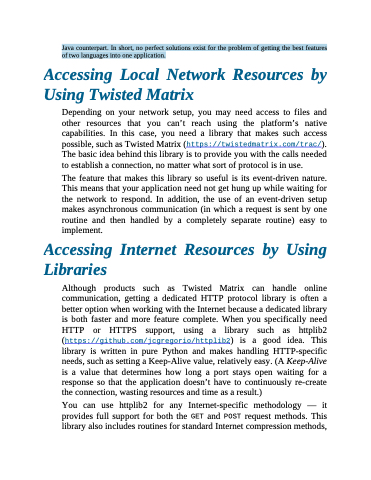Page 449 - Beginning Programming with Pyth - John Paul Mueller
P. 449
Java counterpart. In short, no perfect solutions exist for the problem of getting the best features
of two languages into one application.
Accessing Local Network Resources by Using Twisted Matrix
Depending on your network setup, you may need access to files and other resources that you can’t reach using the platform’s native capabilities. In this case, you need a library that makes such access possible, such as Twisted Matrix (https://twistedmatrix.com/trac/). The basic idea behind this library is to provide you with the calls needed to establish a connection, no matter what sort of protocol is in use.
The feature that makes this library so useful is its event-driven nature. This means that your application need not get hung up while waiting for the network to respond. In addition, the use of an event-driven setup makes asynchronous communication (in which a request is sent by one routine and then handled by a completely separate routine) easy to implement.
Accessing Internet Resources by Using Libraries
Although products such as Twisted Matrix can handle online communication, getting a dedicated HTTP protocol library is often a better option when working with the Internet because a dedicated library is both faster and more feature complete. When you specifically need HTTP or HTTPS support, using a library such as httplib2 (https://github.com/jcgregorio/httplib2) is a good idea. This library is written in pure Python and makes handling HTTP-specific needs, such as setting a Keep-Alive value, relatively easy. (A Keep-Alive is a value that determines how long a port stays open waiting for a response so that the application doesn’t have to continuously re-create the connection, wasting resources and time as a result.)
You can use httplib2 for any Internet-specific methodology — it provides full support for both the GET and POST request methods. This library also includes routines for standard Internet compression methods,


